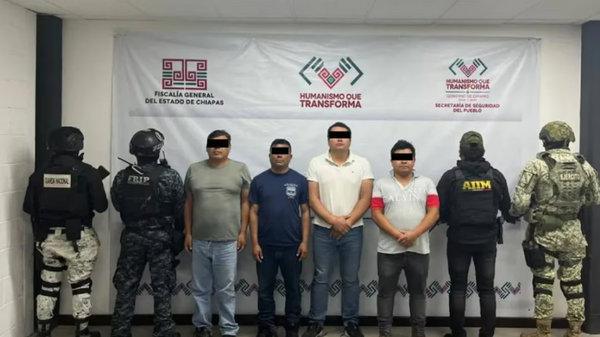
There was a moment, just before the pandemic, when Lisset Sanchez thought she might have to drop out of college because the cost of keeping her three children in daycare was just too much.
Even with support from the state, she and her husband were paying $800 a month – about half of what Sanchez and her husband paid for their mortgage in Las Cruces, New Mexico.
But during the pandemic, that cost went down to $0. And Sanchez was not only able to finish college, but enroll in nursing school. With a scholarship that covered her tuition and free childcare, Sanchez could afford to commute to school, buy groceries for her growing family – even after she had two more children – and pay down the family’s mortgage and car loan.
“We are a one-income household,” said Sanchez, whose husband works while she is in school. Having free childcare “did help tremendously”.
Around the same time, Ofelia Gonzalez and her sister began receiving assistance from the state to develop their at-home childcare center in south-western Albuquerque, called Mis Conejitos. The state started reimbursing their work at higher rates, which allowed them to buy toys and swings for the backyard, and raised wages for childcare workers across the state, which allowed Gonzalez to begin saving “so that I can have good credit and in time I can have my own home”, she said in Spanish.
The changes in Sanchez and Gonzalez’s lives are intertwined. Three years ago, New Mexico became the first state in the nation to offer free childcare to a majority of families. The United States has no federal, universal childcare – and ranks 40th on a Unicef ranking of 41 high-income countries’ childcare policies, while maintaining some of the highest childcare costs in the world. Expanding on pandemic-era assistance, New Mexico made childcare free for families earning up to 400% of the federal poverty level, or about $124,000 for a family of four. That meant about half of New Mexican children now qualified.
In one of the poorest states in the nation, where the median household income is half that and childcare costs for two children could take up 80% of a family’s income, the impact was powerful. The state, which had long ranked worst in the nation for child wellbeing, saw its poverty rate begin to fall.
As the state simultaneously raised wages for childcare workers, and became the first to base its subsidy reimbursement rates on the actual cost of providing such care, early childhood educators were also raised out of poverty. In 2020, 27.4% of childcare providers – often women of color – were living in poverty. By 2024, that number had fallen to 16%.
During the state’s recent legislative session, lawmakers approved a “historic” increase in funding for education, including early childhood education, that might improve those numbers even further.
“This is a big investment that we know is going to pay off,” said Elizabeth Groginsky, cabinet secretary of New Mexico’s nascent early childhood education and care department. She points to research from the Nobel-winning economist James Heckman that “every dollar spent on high-quality, birth-to-five programs for disadvantaged children can deliver a 13% per annum return on investment from better education and health outcomes for children, employment gains for parents, greater economic productivity and reduced spending on healthcare and crime.
“The governor has seen that this investment in our human capital is as important as all the investments we’re making in our infrastructure,” said Groginsky.
Despite the fact that widespread poverty has kept the state’s child wellbeing rates low, “New Mexico had, almost from statehood, a real culture around caring for children,” said Hailey Heinz, a senior research scientist and deputy director of the University of New Mexico’s Cradle to Career Policy Institute.
Both Republican and Democratic administrations have never been “particularly stingy with the social safety net”, she said, citing the Democratic lieutenant governor, Diane Denish, who led efforts to offer free pre-kindergarten to all the state’s four-year-olds in 2005, and the Republican governor, Susana Martinez, who expanded Medicaid in 2013.
After Medicaid was expanded in the state, a coalition of community groups came together to advocate for the next policy they thought could advance child wellbeing: universal childcare.
When now-governor Michelle Lujan Grisham announced her candidacy in late 2016, she emphasized her desire to address the state’s low child wellbeing rating. And when she took office in January 2018, she described her aim to have a “moonshot for education”: major investments in education across the state, from early childhood through college.
That led to her opening the state’s early childhood education and care department in 2019 – and tapping Groginksy, who had overseen efforts to improve early childhood policies in Washington DC, to run it. Then, in 2020, Lujan Grisham threw her support behind a bill in the state legislature that would establish an Early Childhood Trust Fund: by investing $300m – plus budget surpluses each year, largely from oil and gas revenue – the state hoped to distribute a percentage to fund early childhood education each year.
But then, just weeks after the trust fund was established, the World Health Organization declared Covid-19 a pandemic.
“Covid created a really enormous moment for childcare,” said Heinz. “We had somewhat of a national reckoning about the fact that we don’t have a workforce if we don’t have childcare.”
As federal funding flooded into New Mexico, the state directed millions of dollars toward childcare, including by boosting pay for entry-level childcare providers to $15 an hour, expanding eligibility for free childcare to families making 400% of the poverty level, and becoming the first state in the nation to set childcare subsidy rates at the true cost of delivering care.
“The governor saw this as an opportunity to accelerate and advance her agenda for children and families because we had the relief money,” said Groginsky.
As pandemic-era relief funding dried up in 2022, the governor and Democratic lawmakers proposed another way to generate funds for childcare – directing a portion of the state’s Land Grant Permanent Fund to early childhood education and care. Like the Early Childhood Trust Fund, the permanent fund – which was established when New Mexico became a state – was funded by taxes on fossil fuel revenues. That November, 70% of New Mexican voters approved a constitutional amendment directing 1.25% of the fund to early childhood programs.
By then, the Early Childhood Trust Fund had grown exponentially – due to the boom in oil and gas prices. Beginning with $300m in 2020, the fund had swollen to over $9bn by the end of 2024.
The second greatest oil- and gas-producing state in the US, much of New Mexico’s state budget comes from fossil fuels.
“It’s the blessing and curse of living in New Mexico,” said Gabrielle Uballez, executive director of NM Voices for Children. But while oil and gas is booming, she says advocates hope to “take advantage of that so that kids and families are benefiting – not the oil and gas industry by itself, and not corporations by itself”.
New Mexico has long had one of the highest “official poverty rates” in the nation.
But using a metric that accounts for social safety net programs – like universal childcare – that’s slowly shifting. According to “supplemental poverty” data, 17.1% of New Mexicans fell below the federal “supplemental” poverty line from 2013 to 2015 (a metric that takes into account cost of living and social supports) – making it the fifth poorest state in the nation by that measure. But today, that number has fallen to 10.9%, one of the biggest changes in the country, amounting to 120,000 fewer New Mexicans living in poverty.
New Mexico’s child wellbeing ranking – which is based heavily on “official poverty” rankings – probably won’t budge, says Heinz because “the amount of money coming into households, that they have to run their budget, remains very low.
“However, the thing New Mexico has done that’s fairly tremendous, I think, is around families not having to have as much money going out,” she said.
During the recent legislative session, lawmakers deepened their investments in early childhood education even further, approving a 21.6% increase of $170m for education programs – including early childhood education. However, other legislation that advocates had hoped might pass stalled in the legislature, including a bill to require businesses to offer paid family medical leave.
In her budget recommendations, Lujan Grisham asked the state to up its commitment to early childhood policies, by raising the wage floor for childcare workers to $18 an hour and establishing a career lattice for them. Because of that, Gonzalez has been able to start working on her associate’s in childhood education at Central New Mexico Community College where her tuition is waived. The governor also backed a house bill that will increase the amount of money distributed annually from the Early Childhood Trust Fund – since its dramatic growth due to oil and gas revenues.
Although funding childcare through the Land Grant Permanent Fund is unique to New Mexico – and a handful of other states with permanent funds, like Alaska, Texas and North Dakota – Heinz says the Early Childhood Trust fund “holds interesting lessons for other states” about investing a percentage of revenues into early childhood programs.
In New Mexico, those revenues come largely from oil and gas, but New Mexico Voices for Children has put forth recommendations about how the state can continue funding childcare while transitioning away from fossil fuels, largely by raising taxes on the state’s wealthiest earners. Although other states have not yet followed in New Mexico’s footsteps, a growing number are making strides to offer free pre-K to a majority of their residents.
Heinz cautions that change won’t occur overnight. “What New Mexico is trying to do here is play a very long game. And so I am not without worry that people might give it five years, and it’s been almost five years now, and then say, where are the results? Why is everything not better?” she said. “This is generational change” that New Mexico is only just beginning to witness as the first children who were recipients of universal childcare start school.
Sanchez urges other New Mexican families to take advantage of the opportunity to access free childcare.
“Being able to work for free or go to school for free, that can make a big difference in your life and your children’s – everybody’s – life.”







